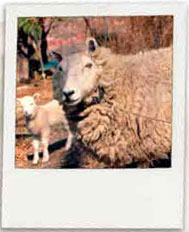Field Notes: A Year (with Sheep & Chickens) at Fallingwater
by Charles Bier
Two weeks after we married in late January, thirty years ago, my wife Terry and I moved to Fallingwater to take up new jobs with the Western Pennsylvania Conservancy.

Frieda and Mary Ellen, once residents of the Barn at Fallingwater
We were caretakers, part of the house maintenance crew, Bear Run Nature Reserve managers and interpretive naturalists for the visitors who came to tour the house.
Those were different times. Fallingwater was generally a quieter place. It is still certainly peaceful today, but there is a much larger staff now and more programs and activities. We lived in a small bungalow adjacent to the ticket house (now the kitchen for the café), and part of our job was to see that people did not enter the grounds during closed hours. The security for Fallingwater was an alarm in our house that would erupt in the middle of the night whenever the Fallingwater residents (white-footed mice) would trip it. Well, come to think of it, that part was not so quiet.
When I married Terry, she came with sheep and chickens, and somehow the Conservancy’s administration was flexible enough to understand. The sheep lived in the barn (now remodeled for staff offices) and they pastured along Route 381. Our small flock of chickens occupied a corner of the small red maintenance barn near our bungalow. Every so often they would venture away from the barn in their bug-hunting forays and visitors leaving the grounds would have to slow down or stop their cars until they scampered off.
The Visitors Pavilion was just new. Each weekend, I led several nature walks on a small path in the forest nearby. I have always enjoyed interpreting any given spot, and this one had a wealth of plants, animals and ecology to share. Sometimes I had to play a few tricks on people whose attention would drift away from my message. So, I would stand alongside a large shrub saying “And this is ‘Nordnedodohr’,” and the visitors were puzzled. Only after I had imparted all of my details about this species would I inform them that it took me a long time to perfect saying rhododendron backwards. On one summer nature walk I spied a northern copperhead right at the edge of the trail. It was a great opportunity to have the visitors experience just how timid this venomous snake really is, and then I had to capture it for release later in a remote area.
Another memorable experience happened as I had just checked on Fallingwater one evening after everyone had left and the grounds were quiet again. I was walking upstream along the path there when a bobcat suddenly appeared in front of me from the rhododendron thicket. It was walking the same direction that I was and must not have detected me due to the sound of Bear Run’s rushing waters. I stalked it for a few minutes as it was weaving in and out of the thicket on the stream bank before disappearing.
Bitter and sweet for me was the offer of a new position as conservation biologist with the emerging Pennsylvania Natural Heritage Program in the Pittsburgh office. So we left Fallingwater and the mountains after just one year. But I took with me memories of many cherished “firsts” during my first year with the Conservancy.
– Charles Bier is the senior conservation scientist for the Western Pennsylvania Conservancy.
